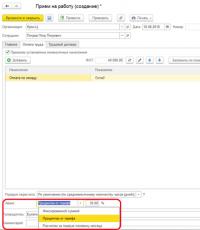Advance calculation in 1s. Advance - fixed amount
Send this article to my email
An advance is a prepayment that is given to an employee against future salary. When paying the employee's salary, the advance amount will be deducted. In this instruction we will consider the question of how to calculate an advance in 1C ZUP.
It should be immediately noted that there are three different types of calculation. The first method is called “Calculation for the first half of the month”, here it is carried out in proportion to the number of days worked. If this option is selected, the advance must first be calculated. The second option is “Fixed amount” and the third option is “Percentage of the tariff”. In the last two cases, the time worked is not taken into account.
If you have questions on the topic of how to calculate an advance in 1C ZUP, ask them in the comments under the article, our specialists will try to answer them.
Initially, the type of accrual in the program is established when preparing personnel documents, such as “Hiring”. On the “Payment” tab we are interested in the “Advance” detail, select one of the above methods. When choosing the third option, you must also specify the percentage; by default, the program is set to 40%.

When applying through the document “Hiring by list”, i.e. in the case where several employees are hired at once, the type of accrual is indicated in the same way.

If one of the methods is already set for an employee, then you can also change it and select another. Do this using the document “Change of advance payment” from the “Salary” section. We create a document and fill in the necessary details.

We indicate the organization and month from which the new payment method or a different advance amount will be applied, if the payment option has not changed. If necessary, fill out the division and change the calculation method. Next we add employees. Click the “Set size” button to set the value for all rows. Then we carry out the document.
The second option is to change the calculation method. To do this, go to the “Salary” section and select the “Change employee pay” item. Next, click “Create” and specify the operation “Change wages”. Fill in the header details.

Check the box “Change advance payment” and select one of the methods. We carry out the document. A third option for changing the method is also possible through the “Personnel Transfer” document. Change Actions
similar.

Next, let's move on to accrual. For the “Calculation for the first half of the month” option, you need to go to the “Salary” section and select the “All accruals” item. Next, click “Create” and select “Accrual for the first half of the month.”

Fill in the details in the header. The program automatically substitutes the 15th date for the calculation date “until”. Then click “Fill”. The document will include those accruals and deductions that have the corresponding checkbox checked.

The document will also calculate deductions and personal income tax. It should be noted that the document will not include employees who were absent on sick leave, vacation, business trips, or other absences. If necessary, the data can be corrected manually. Then we carry out the document.
If the employee has the “fixed amount” or “percentage” option set, then the payment can be made immediately. Payment can be made through a bank, to accounts or to a cash desk. Let’s go to the “Payments” section and select the “All statements for salary payments”. Next, click “Create” and in our example, select the “Statement of Accounts” document.

Fill in the details of the new document and select “Advance” as payment. We fill out the tabular part with employees.
) in 1C 8.2. Today we will look at paying an advance in the 1C Enterprise 8.2 Accounting configuration for Ukraine.
The process of calculating and paying advances to employees of an organization consists of several interconnected stages and begins with the formation of a document... “Payroll.” For the convenience of the reader, we will consider filling out the documents “Payroll” and “Salaries to be issued to organizations” in abbreviated form, specifically in relation to the advance payment. You can read them in more detail using the links located in the header of the article.
So let's get started. Open the “Payroll” tab of the function panel. In the journal of documents of the same name, create a new one by clicking on the “Add” button. In the document that opens, fill in the necessary details. Before creating a new accrual, we pay attention to filling out the regulated production calendar. Having filled in the details in the header and selected an employee, pay attention to checking the “preliminary calculation” checkbox; this is a mandatory item when calculating an advance payment.
 Next, go to the “Salary to be paid” journal, create a new document, fill in its header with the necessary details and pay attention to the “Type of payment” item. Let's set it to “(behind the front opening)”. Next, we will fill out a document on the nature of the payments.
Next, go to the “Salary to be paid” journal, create a new document, fill in its header with the necessary details and pay attention to the “Type of payment” item. Let's set it to “(behind the front opening)”. Next, we will fill out a document on the nature of the payments.

After automatically filling in the accrued advance data, change the data in the “Payment method” column from “Through the bank” to “Through the cash register”. This is necessary for paying an advance to an employee through the cash register and generating a cash expense order (RKO).



We fill in all the necessary details in the cash receipt order created on the basis and after that we save and post the cash settlement document.

If you have questions about the article or there are still unresolved problems, you can discuss them at
Rate this article:
Advance payment is one of the simplest operations carried out monthly by payroll accountants. But, like any operation performed regularly, you want to make it as less labor-intensive as possible, and, naturally, in such a way that the calculations are fully consistent with current legislation. In this article, A.V. talks about how the 1C: Salary and Personnel Management 8 program helps its users solve this problem. Yarvelyan (C Data company, St. Petersburg).
Article 136 of the Labor Code of the Russian Federation
Labor Code of the Russian Federation 09/08/2006 No. 1557-6
Execution of Article 136 of the Labor Code of the Russian Federation
Advance calculation procedure
Article 136 of the Labor Code of the Russian Federation regulates the payment of wages no less than every half month. This point is often understood by the employer as “twice a month,” which is generally incorrect. According to the Labor Code of the Russian Federation, wages must be paid at least every 15 days.
It should also be noted that the concept of “advance” is not defined by the Labor Code of the Russian Federation, as well as the procedure for calculating the amount of the advance. However, the Federal Service for Labor and Employment in its letter dated 09/08/2006 No. 1557-6, citing Resolution of the Council of Ministers of the USSR dated 05/23/1957 No. 566 “On the procedure for paying wages to workers for the first half of the month”, gave an explanation according to which the amount The advance payment is determined by the internal labor regulations, collective agreement, and employment contract, but when determining the amount of the advance payment, the time actually worked by the employee (the work actually performed) should be taken into account.
Compliance with Article 136 of the Labor Code of the Russian Federation is mandatory. Wages must be paid to the employee exactly twice a month; the employer has no right not to pay an advance even if there is a corresponding written application from the employee or a corresponding article in the labor and collective agreement.
Typically, enterprises use one of three options for calculating the amount of the advance: a fixed amount determined for each employee; percentage of the employee’s earnings (30-50%); based on the results of calculating earnings for the first half of the month.
In the program "1C: Salary and Personnel Management 8" two of the above options are implemented: a fixed amount and based on the results of salary calculation for the first half of the month.
Advance - fixed amount
In the 1C: Salary and Personnel Management 8 program, each employee is given a fixed amount of advance payment due to him. Typically, the advance amount is set at approximately 40% of the employee's monthly earnings.
You can compare the amount of the planned advance to an employee directly in the form of a directory list Employees. In this case, the system will automatically install for all existing employment contracts (elements of the directory Employees) of a given individual in a given organization the same advance amount (Fig. 1).
Rice. 1
Information about the amount of the advance payment is stored in the information register (Fig. 2). The register list form can be opened for viewing and editing from the submenu Cash register and menu bank Salary calculation on command Advances to employees of organizations. The amount of planned advances of a specific individual can be found by opening the button Go/Advances to employees of organizations command panel of an individual's card register form with preset selection.
Rice. 2
It should be noted that the size of the planned advance and the amount of the employee’s earnings from the point of view of the program are not related in any way. This means that we set the amount of the planned advance for the employee ourselves, calculating it using an algorithm known to us, but we do not tell the program this formula. Therefore, if you change the salary, hourly rate or other parameters that affect the amount of earnings, the size of the planned advance will not change until we change it manually.
Note also that the planned advance in terms of the program is not an accrual, but rather a payment, therefore the only document that indicates (calculates) the amount of the advance for the specified billing period is the document .
To automatically fill out a document Salaries payable to organizations for payment of a planned advance is necessary in the field Pay indicate Planned advance. In this case, when filling automatically (button Fill), the tabular part of the document is filled in with a list of employees who meet the conditions specified in the document (organization, division, method of payment of wages, etc.), and the corresponding advance amounts from the register Advances to employees of the organization. If a planned advance is not set for an employee, this employee will not be included in the document.
Accounting for absenteeism when paying a planned advance
The program provides the opportunity to limit the payment of advances for employees who were absent from the workplace in the first half of the month due to vacation, sick leave and some other reasons. This procedure does not contradict the above legislative norms, since an advance is payment for the time actually worked for the first half of the month, and in this case the employee did not work during the specified period.
Payment for this time, if it must be paid, is carried out in the form of intersettlement payments (for example, vacation pay) or in the general manner when paying wages for the month.
To apply such a restriction, it is necessary in the form of setting up accounting parameters on the tab Salary payment In chapter Planned advance set flag Take into account absenteeism and indicate the estimated date of the planned advance (see Fig. 3).
Rice. 3
If the employee has not worked in full from the beginning of the month until the calculated date of the planned advance, when automatically filling out the document Salaries payable to organizations, the system will issue a warning (Fig. 4).
Rice. 4
If the employee has not worked a single working hour from the beginning of the month until the calculated date of the planned advance, this employee will not be included in the document Salaries payable to organizations for payment of an advance upon automatic completion of a document.
As mentioned above, the described mechanism does not take into account any employee absenteeism, but a very specific list of them. For example, the absence of an employee due to a business trip does not affect the advance payment in any way.
In order for absenteeism to have an impact on the calculation of the advance in the program, the type of calculation by which it is described must satisfy the following conditions: switch Type of time on the bookmark Time The calculation type form must be set to Unworked full shifts and business trips(Fig. 5); one of the options given in Table 1 should be selected as the type of time according to the classifier.
Rice. 5
|
Letter code |
Full name |
|
Temporary disability with the assignment of benefits in accordance with the law |
|
|
Absenteeism while performing state or public duties in accordance with the law |
|
|
Additional annual leave without pay |
|
|
Annual additional paid leave |
|
|
Absences for unknown reasons (until the circumstances are clarified) |
|
|
Annual basic paid leave |
|
|
Additional leave in connection with training without pay |
|
|
Additional leave in connection with training while maintaining average earnings for employees combining work with training |
|
|
Leave without pay in cases provided for by law |
|
|
Unpaid leave granted to an employee with the permission of the employer |
|
|
Maternity leave (leave in connection with the adoption of a newborn child) |
|
|
Parental leave until the child reaches the age of three |
|
|
Suspension from work (preclusion from work) for reasons provided for by law, without accrual of wages |
|
|
Suspension from work (preclusion from work) with payment (benefits) in accordance with the law |
|
|
Absenteeism (absence from the workplace without good reason for the time established by law) |
Of course, it is always possible to edit, add or delete payroll lines manually.
Advance for the first half of the month
Another way to determine the amount of the advance is to calculate the employee’s actual earnings for the first half of the month. This is what the accrual mode is designed for. First half of the current month in the document Calculation of salaries for employees of organizations.
The document calculates all planned accruals and deductions, as well as personal income tax amounts from these accruals, as in the usual calculation of salaries for the current month. Unlike the usual calculation, the calculation period is taken from the 1st to the user-specified date of the current month, which is in the range from 11 to 22. By default, the system offers the period from the 1st to the 15th of the current month (see Fig. 6).
Rice. 6
Despite the fact that after the calculation the document is externally very similar to the one calculated at the end of the month, the movements it makes through the registers are different. In other words, the fact of calculation and posting of this document will not be reflected in any way on the payslip. The document makes movements in the service register, the information in which is intended for subsequent filling out the payroll for the payment of the advance. When posting a document Calculation of salaries to employees of organizations for the first half of the month, the amounts of accruals minus personal income tax are taken into account, other deductions and loans are not taken into account.
To pay the advance, a document is created, as in the previous case Salaries payable to organizations, the type of payment is indicated Advance payment for the first half of the month. The document is filled in automatically with the data received when posting the document .
You can create a payroll directly from a document Calculation of salaries for employees of organizations via button Create documents for salary payment on the top command bar.
Advance in management accounting
Within the framework of management accounting, only one mechanism for paying advances has been implemented - planned. You can set the amount of the planned advance for an employee in management accounting in the information register Advances to employees.
You can open the register form through the menu Go directory element forms Individuals or through the command Payment of salaries/advances to employees menu Settlements with personnel.
When an advance is paid, a document is automatically filled in Salary payable with payment type Planned advance. When paying a management advance, the program does not automatically take into account any no-shows. All changes to the advance amount must be made manually.
Simplified accounting of mutual settlements
When talking about the nuances of paying salaries to employees, it is impossible to ignore the new opportunity provided to users in the latest configuration releases.
Now users can simplify the procedure for processing salary payments in the program and do not have to issue payment orders and cash receipts.
In order to “turn on” the simplified mechanism, just go to the accounting settings on the tab Salary payment set flag Simplified accounting of mutual settlements.
Simplified accounting can be applied to either one or several organizations, depending on the need. When simplified accounting of mutual settlements is enabled, the fact of payment of wages in the information system is the posting of a document Salaries payable to organizations.
At the same time, the appearance of the payroll itself changes somewhat - the column disappears Document, and in the column Mark when filled in, the default value is set in all lines Paid.
The date of payment of wages under such a system is considered to be the date of the payroll.
In management accounting, simplified accounting of mutual settlements is not yet provided.
In 1C 8.3 ZUP, an advance is understood as a kind of prepayment that is issued in advance towards the upcoming salary. If at the time of payment of the advance the organization did not have a salary debt to its employee, then this amount is the debt of the employee himself. If planned, the advance amount will be deducted from it.
In this article we will look at step by step, for beginners, the calculation and accrual of advances in 1C ZUP 8.3.
The advance can be calculated in various ways:
- a fixed amount,
- % of the employee's wage fund,
- calculation of wages for the first half of the month.
Initially, the type of advance payment in 1C ZUP is set by personnel documents, changes in wages, advance payments, etc. In this article, we will set up an advance payment when hiring.
We created an employee recruitment and went to the “Payment” tab. At the bottom of the window, from the corresponding drop-down list, you can select one of the methods for calculating the advance payment, which were mentioned earlier. In this case, the advance payment to Alexander Matveevich Vankov will be paid in the amount of 35% of the tariff (wage fund). The default value was forty percent.
All this data will be displayed in the employee’s card.

In the figure you can see that the wage fund is 10,000 rubles, therefore, the advance amount will be 3,500 rubles.
Advance calculation
The calculation of the advance in the 1C 8.3 ZUP 3.1 program is made only if in the previous paragraph you indicated that it is paid “Calculation for the first half of the month.”

Just like when calculating wages, before calculating the advance, you must enter into the program all days of absence of the employee.
Let's assume that our employee S.N. Bazhova took leave without pay for the period from August 7 to August 8, 2017 inclusive. We must reflect this data in the program. Moreover, in order for this failure to appear to be taken into account when calculating the advance, as well as when calculating wages, the “Calculation approved” flag must be set in the document itself.

Now you can proceed to calculating the advance payment. Go to the “Salary” section and select “All accruals”.

In the list form that opens, click on the “Create” button and select the appropriate item, as shown in the figure below.

The header of the document is filled out as standard. In this case, we make the accrual until August 15, 2017. After specifying all the data, click on the “Fill” button and all the necessary data will be included in the document automatically.
In the figure below we see that employee S.N. Bazhova only has 9 days worked instead of 11 according to the standard. Thus, the amount of the advance was calculated based on a salary of 70,000 rubles for 9 days.

Please note that, unlike payroll, this document does not produce actual accrual. He only calculates the amount of the advance.
In addition to calculating the advance, this document also reflects deductions, for example, on writs of execution and personal income tax. All this data, as well as accrued amounts, are subject to manual adjustment. An example would be an employee’s personal request to pay a larger or smaller amount as an advance.
Please note that employee A.M. Vankov was not included in the document. This happened because we had previously established an advance payment for him in the amount of 35% of the payroll amount. In this regard, the advance payment can be made without an accrual document.
Advance payment
You can start paying the advance immediately for those employees for whom it is accrued either as a fixed amount or as a percentage of the payroll. Be careful, because in this case, those employees who were absent from the 1st to the 15th (for example, leave without pay, etc.) will not be included in the payroll.
Go to the “Payments” section and select “All statements”.

In the window that opens, you can select the method by which the advance payment will be made.

In the header of the created document, in the “Pay” field, select “Advance” and indicate for which month it needs to be paid. After that, click on the “Fill” button.
For those employees whose advance payment is a percentage of the payroll, or a constant amount, the advance amount will be automatically calculated and will appear in the tabular part of the document. For those whose advance payment is calculated for the first half of the month, the figures will also be displayed in the document if the corresponding accrual was previously made, as described by us earlier.

Hello dear blog readers. In the next article we will talk about formations and advance payment in a software product "1C Salary and HR Management". This material will propose two automation methods for calculating the amounts of advance payments to employees:
- Advance in a fixed amount;
- The advance payment for the first half of the month is proportional to the days worked.
I will also remind you of the global settings that the program has regarding advance payments, and the principles of working with the document "Salary payable".
Let me remind you that the site already has a fairly detailed overview of how 1C ZUP pays salaries to the organization’s employees: . I also wrote about the settings in the accounting parameters in the light of salary payments.
✅
✅
This option, according to my observations, is the most used among accountants, and is also quite simple from the point of view of implementation in the 1C Salary and Personnel Management program. It is carried out using one directory “Employees of the organization” and one document "Salary payable."
First, in the “Employees of Organizations” directory, in the “Advance” field, you need to indicate the amount, which is a fixed advance for each employee.
After this, everything is ready to pay the advance. Open the document “Salaries payable”.

✅
✅ CHECKLIST for checking payroll calculations in 1C ZUP 3.1
VIDEO - monthly self-check of accounting:
✅ Payroll calculation in 1C ZUP 3.1
Step-by-step instructions for beginners:


In these reports you can see payments totaling 74,390. This is the payment of the main part of the salaries to employees for January, which were made in February. But advance payments formed a debt for employees at the end of the month. This debt will remain until we pay wages. After this, to pay the remaining part of the salary, you will also need to use the “Salaries payable” document. The program will automatically fill in the payment amounts minus the advance already paid. See the very end of this article for more details.
Advance for the first half of the month in proportion to days worked
✅ Seminar “Lifehacks for 1C ZUP 3.1”
Analysis of 15 life hacks for accounting in 1C ZUP 3.1:
✅ CHECKLIST for checking payroll calculations in 1C ZUP 3.1
VIDEO - monthly self-check of accounting:
✅ Payroll calculation in 1C ZUP 3.1
Step-by-step instructions for beginners:
Sometimes it becomes necessary to pay an advance for half a month in proportion to the time worked. For this purpose, the 1C Salary and Personnel Management program has special functionality. For this we need a document "Payroll" and of course "Salary payable".
Open the “Payroll” document. It is necessary to indicate the month of accrual and in the “Accrual mode” field be sure to select “First half of the current month”. After that, use the “Fill” button to get a list of employees with their accruals in the tabular section and use the “Calculate” button to calculate the advance payment for the first half of the month. Please note that employees have not only basic planned accruals as accruals, but also additional planned accruals (employee Sidorova has “Salary by day” and “Bonus percentage of salary”).

In this case, personal income tax will also be calculated. Thus, the advance is calculated minus personal income tax.

Let's make sure that the advance will indeed be calculated in proportion to the time worked. Let employee Sidorova take a day off at her own expense on February 5th. We will reflect this event using the document “Absenteeism in the Organization.”

After this, let’s return to the “Payroll” document and calculate the advance again.

I would like to specifically note one thing very important circumstance.

After calculating the advance in the “Payroll” document, you need to post it and refer to the document "Salary payable". In it we indicate the month of accrual and in the “pay” field we select “Advance payment for the first half of the month”. Click the “fill” button. As a result, the tabular part will be filled in by employees for whom the advance payment for half the month is calculated, minus personal income tax.

As in the first case, after posting the “Salary Payable” document, the employee’s debt to the organization will form. Now, when it’s time to calculate your salary for February, let’s open the “Payroll” document, fill out and calculate the document. note that it will be calculated for the entire month from the first day.

Let's open the report "Payslip" And "Accrued salary summary" for February.


Please note that the amounts of the advance and the amount of debt to employees, which was formed as a result of payroll, are almost the same. The only discrepancies are with employee Sidorova, who had one day off in the first half of the month, so the amount of the advance is less than the organization’s debt to her for the rest of the month.
The remaining part of the salary for February will be paid in March and this fact is recorded in the document "Salary payable" in which the type of payment is indicated "Salary".

This unique mechanism for calculating an advance for half a month is offered to us by the Salary and Personnel Management software product.
That's all for today! Soon there will be new interesting materials on
To be the first to know about new publications, subscribe to my blog updates:




